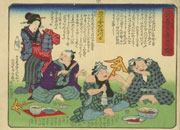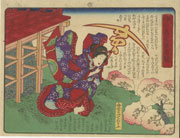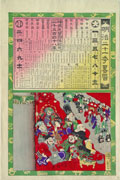Prints in Collection
Nakamura Shikan IV , Ichikawa Sadanji and Onoe Kikugorō V in Kagamiyama wakabo no momiji at the Chitoseza, 1889
IHL Cat. #1274
Biographical Data
Biography
Utagawa Fusatane 歌川 房種 (active 1854-1889) was a student of Utagawa Sadafusa (active 1825-1850). His signatures include Ōsai (櫻斎 or 桜斎), Isshōsai (一笑斎), and Ippyōsai (一瓢斎). His original name was Murai Seima (村井 静馬). The dates of his birth and death are not known. Various dates are given for his "active" periods with an earliest date of 1849 and the latest date being 1888. The Museum of Fine Arts, Boston lists 1854-1888 as his active period.
Source: The Hotei Encyclopedia of Japanese Woodblock Prints, Amy Reigle Newland, Hotei Publishing Company, 2005, p. 503
Act. c. late 1850s-70 – Edo/Tokyo print designer. A pupil of Utagawa Sadafusa. Fusatane produced fukeiga (pictures of landscapes), bijin-ga (pictures of beautiful women) and fūzokuga (pictures of manners and customs), including subject-matter of kaika-e (pictures of Japan's modernization). His bijin reflect the drawing style of Utagawa Kunisada (1786 - 1865) and Sadafusa, while his landscapes were strongly influenced by Utagawa Hiroshige (1797-1858). His Genji mitata-e (parody pictures) sets include From Genji in the Four Seasons (Genji shiki no uchi, 8/1862). At his best Fusatane could rise above ordinary, as in his series of uchiwa-e titled Complete Famous Places of Former Times (Kodai meisho soroi, c. 1847-52) featuring half-length portraits of beauties posed before Hiroshige-style views. Other gagō: Isshosai, Ippyosai.
Two prints from his comic series Inochi No Youjyo Zen Aku Kagami (Reflection on Good and Evil for a Healthy Life) featuring the character for life, "inochi," are part of this collection.
A Second Rate Artist?
Source: The Maintenance of Tradition in the Face of Contemporary Demands: A Reassessment of Meiji Prints, Oikawa Shigeru, article appearing in The Hotei Encyclopedia of Japanese WoodblockPrints, Amy Reigle Newland, et. al., Hotei Publishing, 2005, Volume 1, p. 262.Asa consequence of the economies in print production that Meiji erapublishers were trying to achieve "was the widespread practice ofemploying second-rate artists such as Utagawa Kunitoshi (1847-1899), Utagawa Kunihisa (active c. 1800-20) and Utagawa Fusatane (active c. late 1850s-70). They could churn out slapdash, easy-to-produce designs, in contrast to masters like Utagawa Sadahide (1807-1873), Kawanabe Kyōsai (1831-1889), Yoshitoshi Tsukioka (1839-1892) and others whose compositions involved intricate line-work.
Signatures of Artist (A Sampling)
 一笑斎房種画 Isshōsai Fusatane ga 1852 |  Fusatane ga within Toshidama cartouche 1854 |  Fusatane ga 1854 |  ōju Ōsai Fusatane hitsu with unread seal 1854 |  unread 1856 |  ōju Fusatane ga with unread seal 1862 |  Fusatane ga within Toshidama cartouche 1862 |  ōju Fusatane unread character ga 1862 |
 應需 房種画 ōju Fusatane ga with unread seal 1862 |  Ōsai Fusatane hitsu 1878 |  Ōsai Fusatane 1879 |  Ōsai Fusatane ga 1879 |  Ōsai Fusatane hitsu 1888 |  ōju Fusatane hitsu 1888 |  一笑斎 Isshōsai Fusastane ga c. 1860s |




